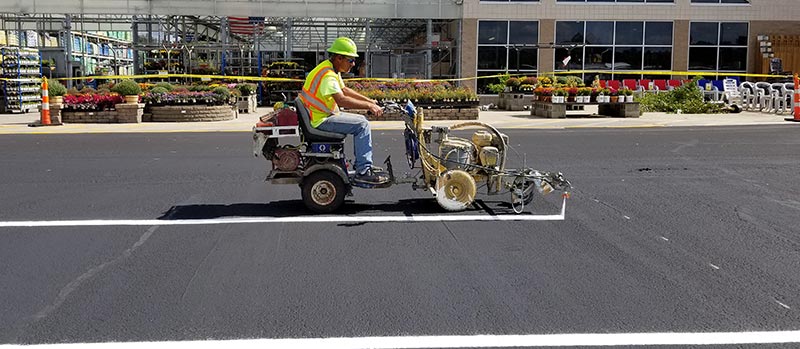A1 Professional Asphalt & Sealing Llc - The Facts
A1 Professional Asphalt & Sealing Llc - The Facts
Blog Article
Get This Report on A1 Professional Asphalt & Sealing Llc
Table of ContentsThe smart Trick of A1 Professional Asphalt & Sealing Llc That Nobody is DiscussingSome Known Incorrect Statements About A1 Professional Asphalt & Sealing Llc Everything about A1 Professional Asphalt & Sealing LlcThe 10-Second Trick For A1 Professional Asphalt & Sealing LlcExamine This Report on A1 Professional Asphalt & Sealing Llc

The oil in an auto engine is not just oil. The REOB includes all the additives that were in the waste oil as well as the wear steels from the engine (mostly iron and copper).
Nonetheless, by making numerous blends using various REOB samples and various asphalt binders, the variants mainly can be averaged out. Numerous States offered examples of well-known REOB structure to TFHRC scientists, who assessed the examples to compare the portion of included (understood) REOB to the located (evaluated) quantity. The analyses revealed a similar percentage of added and found REOB.
Get This Report on A1 Professional Asphalt & Sealing Llc
They got a frustrating response. The TFHRC scientists analyzed 1,532 samples from 40 States, one Canadian district, and two Government Lands Freeway divisions. They evaluated each example twiceamounting to more than 3,000 analyses. None of those States recognized that the asphalt they were acquiring included REOB. One State insisted its samples had no REOB.
Of the 1,532 samples evaluated, 12 percent had REOB, and some had appreciably high degrees of it at 1020 percent. The greatest degree was 34 percent in a sample from Texas, which TxDOT had actually made use of in a patching compound. This testing likewise exposed the visibility of phosphoric acid in 11 percent of the samples, and 2 percent consisted of ground tire rubber.
Two years back at TRB's annual meeting, the Federal researchers held an REOB workshop and provided the findings of their lab analyses to a standing room-only group. Although some companies do not particularly ban REOB, they do impose physical examinations that avert its useeffectively a ban. asphalt sealcoating in st louis. Others do not outlaw it by specification, yet have contracts with asphalt providers to prevent using REOB
A1 Professional Asphalt & Sealing Llc - An Overview
A handful do enable REOB, some within specific limits. Ohio and Texas restriction degrees to much less than 5 percent of the asphalt. To develop a trusted test method that all States can make use of, the TFHRC researchers established a round-robin examination strategy. The individuals are 11 State highway firms (Illinois, Massachusetts, you can find out more Minnesota, Mississippi, Montana, North Carolina, Oklahoma, South Carolina, Texas, Vermont, and Wyoming), 2 independent screening laboratories, the Ministry of Transport in Ontario, Queen's University in Ontario, and an Ontario paving specialist.
The individuals are testing the samples independently using the guidelines provided by the TFHRC researchers. The output will certainly be a proposed AASHTO examination technique that any State can embrace and use.
The sidewalk with REOB, which is situated 0.6 mile (1 kilometer) from the sidewalk without REOB, has similar subgrade, web traffic thickness, and climate. Nevertheless, the section of Highway655 with 5 to 10 percent REOB showed considerable fracturing. In this example, the presence of REOB was the recognized reason for splitting at a reduced temperatures.
An area of examination pavement in Minnesota (MN1-4) located to include REOB additionally cracked too soon. The sidewalk performed well for the very first 3 to 4 years, however then began to break.
Facts About A1 Professional Asphalt & Sealing Llc Revealed
The tests were not comprehensive, however they revealed that at levels of 6 percent or even more, the tensile toughness of the asphalt went down substantially. At a degree of 3.5 percent REOB, the variation in the physical examination approaches was better than the result of REOB. As a matter of fact, it was hard for scientists to assess whether REOB existed.

One binder criterion considered is the distinction in between the reduced temperature crucial spec temperature level for rigidity (S) in the bending light beam rheometer and the bending beam of light rheometer creep incline (m-value) kept in mind as Tcritical. TC = TC (S) TC (m-value). Evaluation of this parameter is still continuous. 2 independent research groups, one from AASHTO and the various other from the Asphalt Institute, wrapped up that more research is needed on making use of REOB in asphalt.
Previously, all asphalt screening determined engineering residential properties such as rigidity. These tests do not reveal what products had been contributed to the asphalt. One example gotten throughout the TFHRC study had a very weird analysis. The example had the complying with examination results: Superpave PG 64-28 with a heat quality of 67.3 Tcritical on the bending beam rheometer was 6.7 degrees Celsius.

Facts About A1 Professional Asphalt & Sealing Llc Revealed
These results show there are weaknesses in the standardized engineering testing procedures that might be manipulated. The manufacturer might have a financial advantage and the product passes all the standard tests, however the item might not be useful to ensuring long-lasting efficiency. To resolve this concern and the development of new asphalt ingredients and extenders, TFHRC is starting a research study program to utilize portable spectroscopic gadgets, x-ray fluorescence spectroscopy, and Fourier change infrared spectroscopy to enable analyses to be carried out in the field instead than needing to take examples back to the laboratory.
Report this page